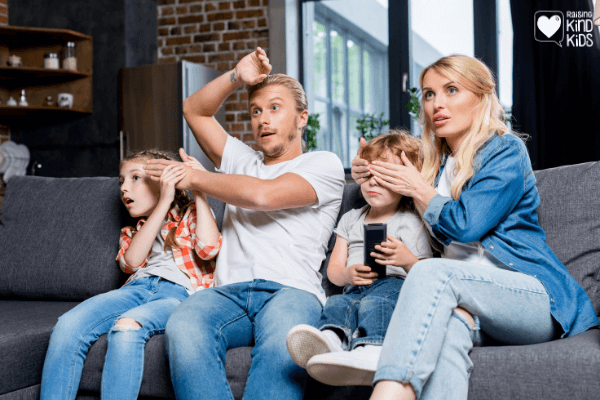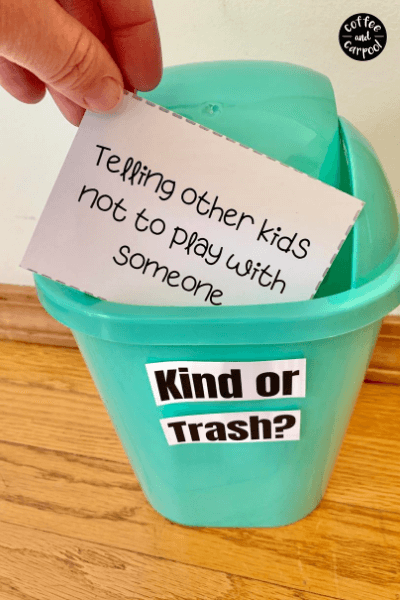Inside: Help your kids deal with negative media influences and balance it with your family values of kindness, empathy, and compassion with these 6 strategies.
My hubby and I made a list of all the movies we watched as kids we wanted to show to our kids and the top of our list was the Goonies.
We cringed with the language although my kids know they can hear “bad words” and not repeat them.
But the part that really got me ready to turn it off was the Truffle Shuffle.
We were raised on The Goonies and the Truffle Shuffle. It’s pop culture and clearly engrained in our 80s childhoods.
But through a parents’ lens watching my kids watch this, I was horrified.
It normalized “friends” bullying someone for a laugh. And we laughed right along with it. Because we didn’t know any better.
So now as my kids watch their TV shows, I hear similar nasty, cruel and bullying situations because my kids no longer watch Sophia the First and Mickey Mouse Clubhouse and Jack’s Big Music Show.
Instead, they’ve “graduated” to the Disney Channel Shows where the characters are awful to their friends and even more awful to their parents.
I can’t even tell you the number of times I cringed with the one-line zinger or the cruel slapback and then cringed even more when my kids laughed right along with the laugh track.
But in our house, because we’re raising kind kids, we’re also monitoring the cruelty, the teasing, the backtalk, the oneliners, and the bullying behaviors that my kids see in these TV shows and movies and video games.
So because media has normalized these unkind behaviors, it’s our job as parents to ensure our kids don’t think what happens on the screen is what should happen in real life.
If we want to raise kind kids, we have to ensure that when they see unkindness on the screen, it doesn’t influence their behaviors off-screen.

Why Monitoring Media and Unkindnenss is Essential
For better or worse our kids consume media: TV, movies, video games, online videos.
And as parents, it’s our job to monitor it. We know this. There’s nothing new there.
Of course, we’re aware of the gratuitous violence and the mature or sexual content, and the foul language.
But we also have to pay attention to and talk about cruelty, unkindness, and bullying we see in these shows.
Goonies never say die, but The Truffle Shuffle is plain awful.
So I let my kids watch The Goonies, but we watched with them. And we paused both before the Truffle Shuffle and after and talked about it.
We asked them very specific questions to make sure they understood the cruelty of it. And even though Mouth was laughing, Chunk wasn’t. And then we talked about nicknames and why “Chunk” is grossly inappropriate and cruel and good and true friends would never call you names based on your appearance.
My kids also love America’s Funniest Videos and even though Bob Saget is no longer hosting it, the laugh when someone gets hurt concept is still alive and well.
If we don’t want our kids laughing when a friend or classmate falls in real life, we have to create a disconnect between media influence and real life.
We have to tell our kids it’s not funny when someone falls.
It’s not funny when someone is made fun of in front of everyone.
It’s not okay to speak to your parents like absolute dirt.
Why? Because when our kids see these behaviors done by their favorite YouTubers or favorite actors who get more popular because of it, it normalizes the cruelty, the backtalk, and the bullying behavior.
Since our kids are super impressionable and they’re learning how to speak and act from watching others, we need to control the influences that we allow to mold them.
So if we want our kids to be kind, and compassionate, and good, true friends, we have to talk to them about negative media influence and our family values.

How to Deal with Negative Media Influence:
1.Make Kindness a Family Rule
One of the easiest ways to remind our kids about how to deal with negative media influences is to remind them of our two family rules.
If Be Kind is one of our family rules, and we are consistent in our messaging, they will have less confusion when they see characters in TV shows and movies being unkind. Here’s why our 2 Family Rules work and why they’re the only two rules you’ll need.
2. Play Trash or Kindness
We play this Trash or Kindness Game to help our kids understand tricky social situations and decide what is kind and what isn’t.
You can play this game to help them see the cruel one liners and bullying behaviors for what they are: unkind actions that shouldn’t be considered funny.
3. Hear it, don’t repeat it
My kids know they can hear bad words, they just can’t repeat it. But we also have to remind them this is true with sarcasm, mean comebacks, and cruel teasing.
We remind them of the 15 words and phrases we’ve banned in our house to make it a kind and safe environment.
Every once in a while they forget and try out a line they heard in a show. But we pause the conversation. We explain to them how rude or unkind their one-liner really is and they need to try again.
4. Talk about it
We talk about the shows and how the characters are speaking while they’re watching.
- Is that how we speak in our family?
- I don’t think that was a kind thing they said.
- Is that how good friends treat each other?
- Why is that funny?
- Should we laugh when someone gets hurt?
- Are these characters people you would want to be friends with?
- They’re not being respectful to other people.
- Is what they said in line with our family values?
- Does this show feel like real life? Is that how we speak and act in real life?
If you want to keep the conversation going, download our free Media Influence Discussion Starters below.

5. Explain the Laugh Track to them
Sitcoms have used the laugh track for decades. It’s the forced, audience encouraged, or recording of people laughing. And TV sitcom producers play it whenever there’s a one-liner they want the audience at home to think is funny.
Even if the “joke” misses its mark, if the studio audience is laughing or we hear others around us laughing, we laugh. Or we laugh harder.
Encourage your kids to listen for the laugh track. Simply noticing it is half the battle.
Then ask them to decide if the character’s line or situation was truly funny to them or if someone else is deciding for them. Challenge them to decide if something is funny to them and laugh only when it really is funny.

6. Ban Shows That Don’t Align with Your Family Values
Just because a show is on the Disney Channel or Nick Junior or is presented in cartoon form does not mean it’s kid-friendly or family-friendly.
If a TV show or movie consistently has characters speaking poorly to their parents or bullying siblings and friends, or has the sass, backtalk that as the norm, calmly shut it down, with no guilt.
Explain to your kids why you don’t want them watching it. Remind them there are tons of other funny shows out there. And as soon as they can show you they can hear this awful stuff and not repeat and not let it influence their behavior, you might be able to bring it back.
Even if it’s not a popular decision in your home, we know it’s our job as parents to judge which media influences our kids can not and should not be around so they become kind, empathetic, thoughtful people.
We are raising a generation that doesn’t find The Truffle Shuffle funny or normal behavior.
And thank goodness for that.
Download the Media Influences Discussion Starters here.






Leave a Reply